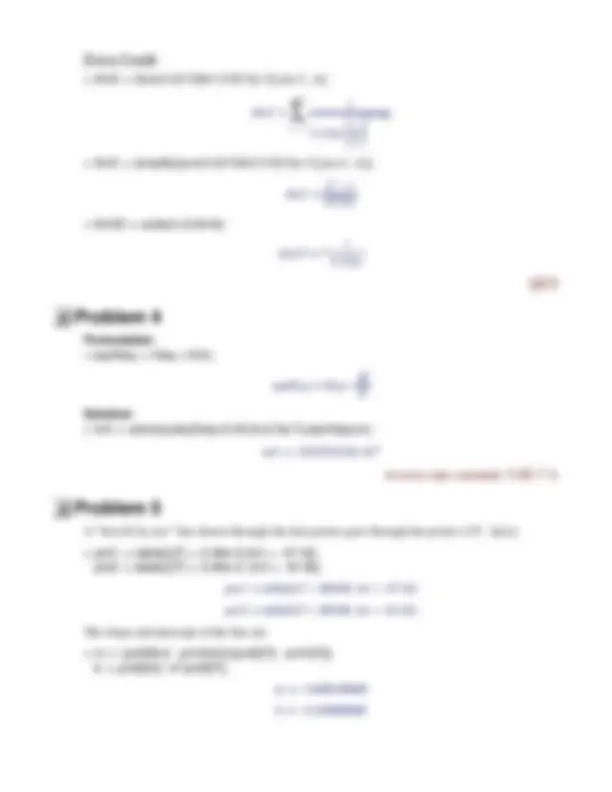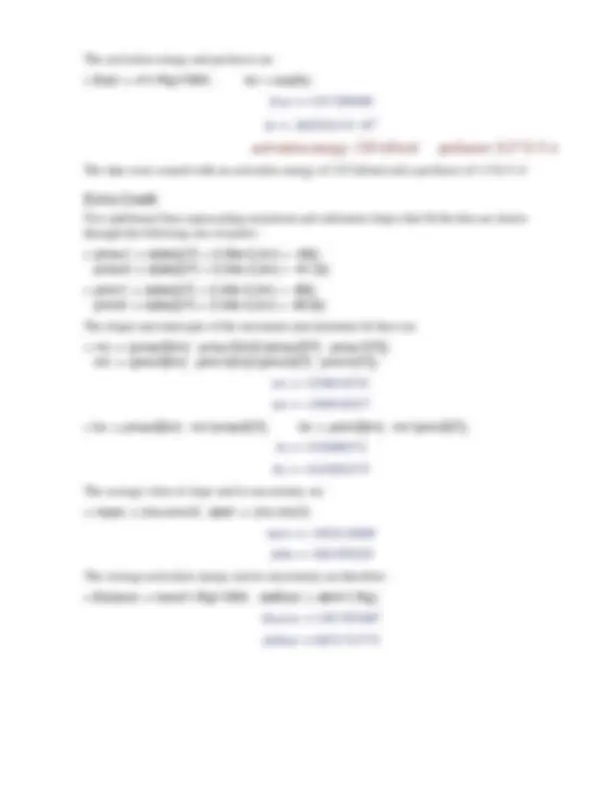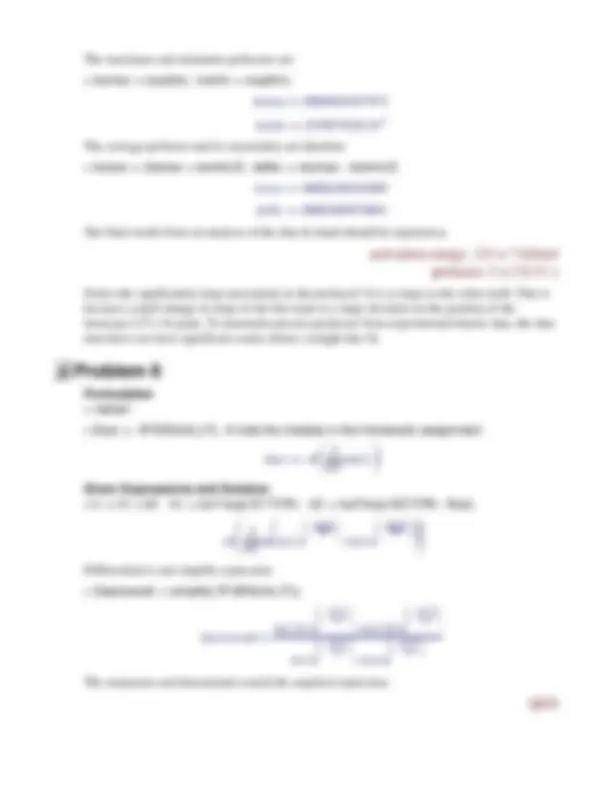





Study with the several resources on Docsity

Earn points by helping other students or get them with a premium plan


Prepare for your exams
Study with the several resources on Docsity

Earn points to download
Earn points by helping other students or get them with a premium plan
Community
Ask the community for help and clear up your study doubts
Discover the best universities in your country according to Docsity users
Free resources
Download our free guides on studying techniques, anxiety management strategies, and thesis advice from Docsity tutors
The solutions to homework problem 9 in a chemical reaction kinetics course. It includes the calculation of reaction rate ratios, time constants, and activation energies using given rate equations.
Typology: Assignments
1 / 5

This page cannot be seen from the preview
Don't miss anything!




restart: readmylib(pchemconstants):
Formulation and Solutions
eqnRateRatio := r2/r1 = (C2/C1)^p: alpha := solve(subs({r2=2.05,C2=2,r1=1.00,C1=1},eqnRateRatio),p); α :=1. beta := solve(subs({r2=5.62,C2=2,r1=2.05,C1=1},eqnRateRatio),p); β :=1. g := solve(subs({r2=0.21,C2=.05,r1=1,C1=0.01},eqnRateRatio),p); g :=-. delta := solve(subs({r2=1.01,C2=.05,r1=1,C1=0.01},eqnRateRatio),p); δ :=.
Formulation and Solution
eqn1stOrder := CA = CAoexp(-kt): ta := solve(subs({CA=0.75,CAo=1,k=4.5e-5},eqn1stOrder),t); ta :=6392.
Formulation and Solution
eqn1stOrderHL := th = ln(2)/k: tb := evalf[3](subs(k=4.5e-5,rhs(eqn1stOrderHL))); tb :=15400.
td := solve(eqn1stOrder,t); kh := solve(eqn1stOrderHL,k);
td :=−
ln CA CAo k
kh :=
ln 2( ) th
tc := subs({CA=f*CAo,k=kh},td);
tc :=−
ln( ) f th ln 2 ( )
skAGE := evalf3; skAGE :=7520.
Formulation and Solution
eqn2ndOrder := CA = CAo/(1 + ktCAo): ta := solve(subs({CA=0.75,CAo=1,k=4.5e-5},eqn2ndOrder),t); ta :=7407.
Formulation and Solution
eqn2ndOrderHL := th = 1/(k*CAo): tb := evalf[3](subs({k=4.5e-5,CAo=1},rhs(eqn2ndOrderHL))); tb :=22200.
The activation energy and prefactor are
Eact := m*(-Rg)/1000; ko := exp(b);
Eact :=119. ko :=.2652521131 10 -
The data were created with an activation energy of 125 kJ/mol and a prefactor of 1.5 E-5 /s!
Two additional lines representing maximum and minimum slopes that fit the data are drawn through the following sets of points:
pmax1 := table([(iT) = 2.48e-3,(lnr) = -48]): pmax2 := table([(iT) = 3.34e-3,(lnr) = -61.2]):
pmin1 := table([(iT) = 2.42e-3,(lnr) = -48]): pmin2 := table([(iT) = 3.34e-3,(lnr) = -60.6]):
The slopes and intercepts of the maximum and minimum fit lines are
mx := (pmax2[lnr] - pmax1[lnr])/(pmax2[iT] - pmax1[iT]); mn := (pmin2[lnr] - pmin1[lnr])/(pmin2[iT] - pmin1[iT]); mx :=-15348. mn :=-13695.
bx := pmax2[lnr] - mxpmax2[iT]; bn := pmin2[lnr] - mnpmin2[iT];
bx :=-9. bn :=-14.
The average value of slope and its uncertainty are
mave := (mx+mn)/2; delm := (mx-mn)/2;
mave :=-14522. delm :=-826.
The average activation energy and its uncertainty are therefore
Eactave := mave(-Rg)/1000; delEact := delm(-Rg);
Eactave :=120. delEact :=6872.
The maximum and minimum prefactors are
komax := exp(bx); komin := exp(bn); komax :=. komin :=.3530974520 10 - The average prefactor and its uncertainty are therefore koave := (komax + komin)/2; delko := (komax - komin)/2; koave :=. delko :=.
The final results from an analysis of the data by hand should be reported as
Notice the significantly large uncertainty in the prefactor! It is as large as the value itself. This is because a small change in slope of the line leads to a large deviation in the position of the intercept (1/T = 0) point. To determine precise prefactors from experimental kinetic data, the data must have not have significant scatter about a straight line fit.
Formulation
restart: Eact := -R*Diff(ln(k),iT); # note the mistake in the homework assignment
Eact :=− R
iT ln( k )
Given Expressions and Solution
k := k1 + k2: k1 := ko1exp(-E1iT/R): k2 := ko2exp(-E2iT/R): Eact;
iT
ln ko1 e +
^
− (^) E1 iT R ko2 e
^
− (^) E2 iT R
Differentiate k and simplify expression
Eactoverall := simplify(-R*diff(ln(k),iT));
Eactoverall :=
ko1 E1 e +
^
− (^) E1 iT R ko2 E2 e
^
− (^) E2 iT R
ko1 e +
^
− (^) E1 iT R ko2 e
^
− (^) E2 iT R
The numerator and denominator match the required expression.